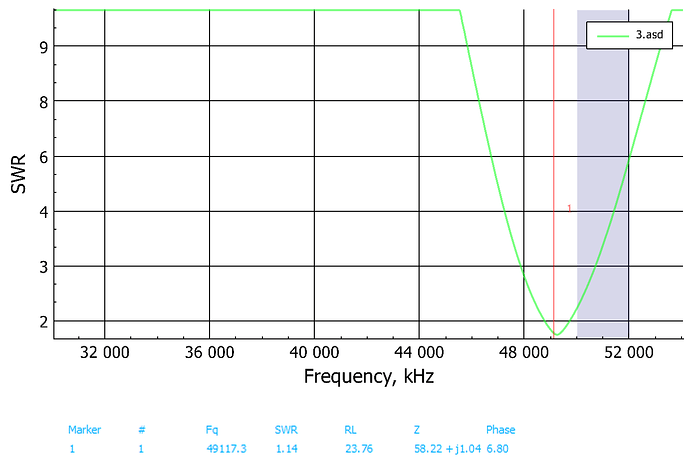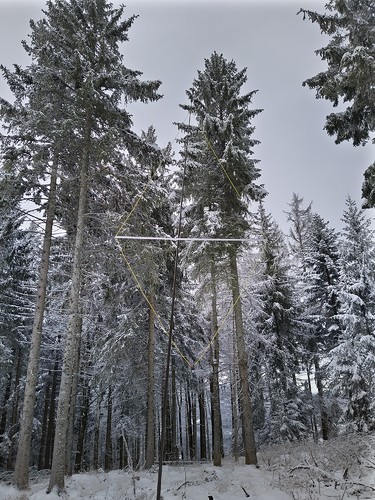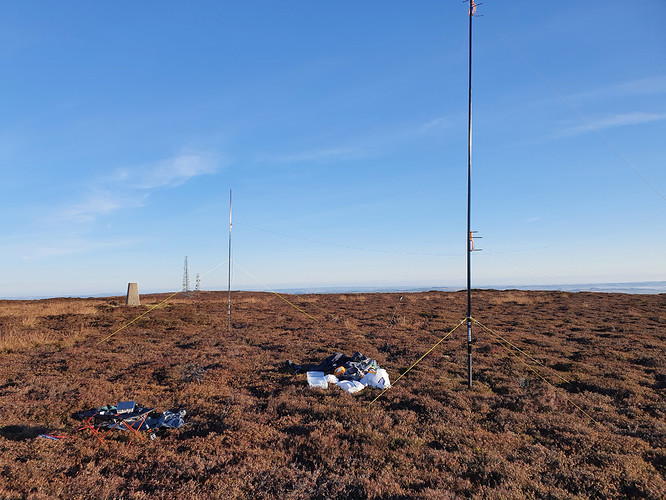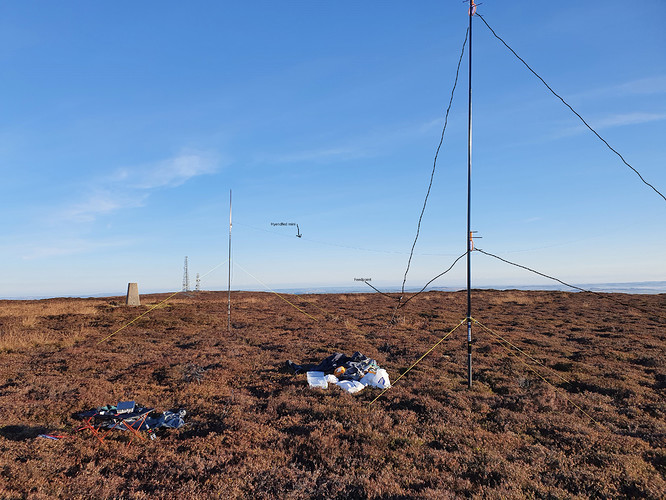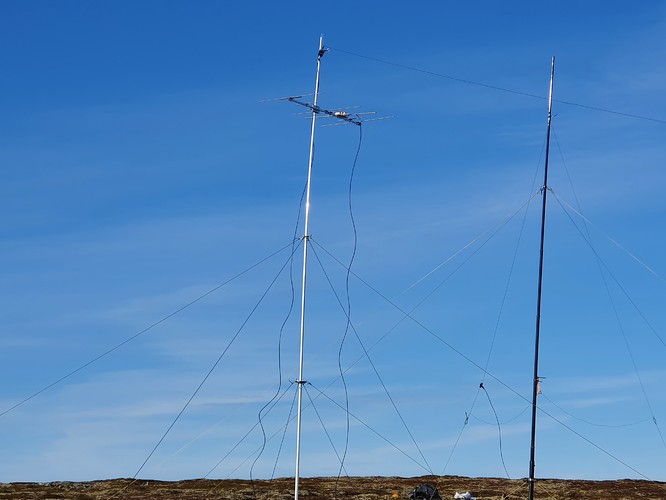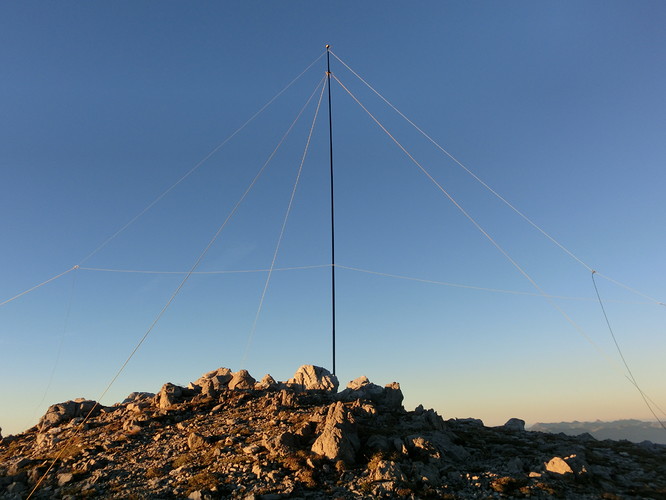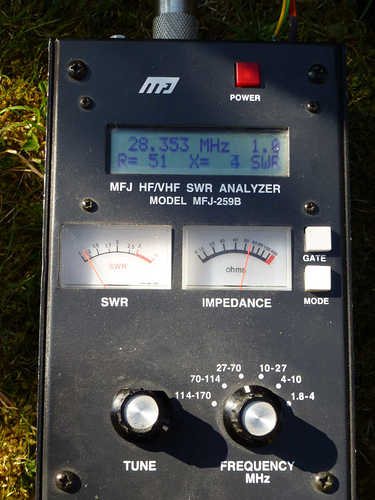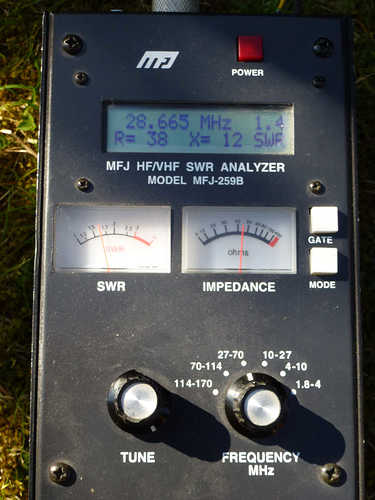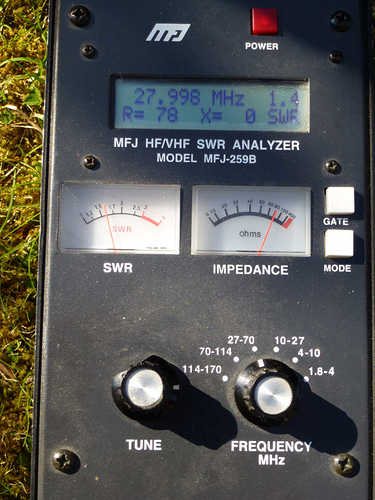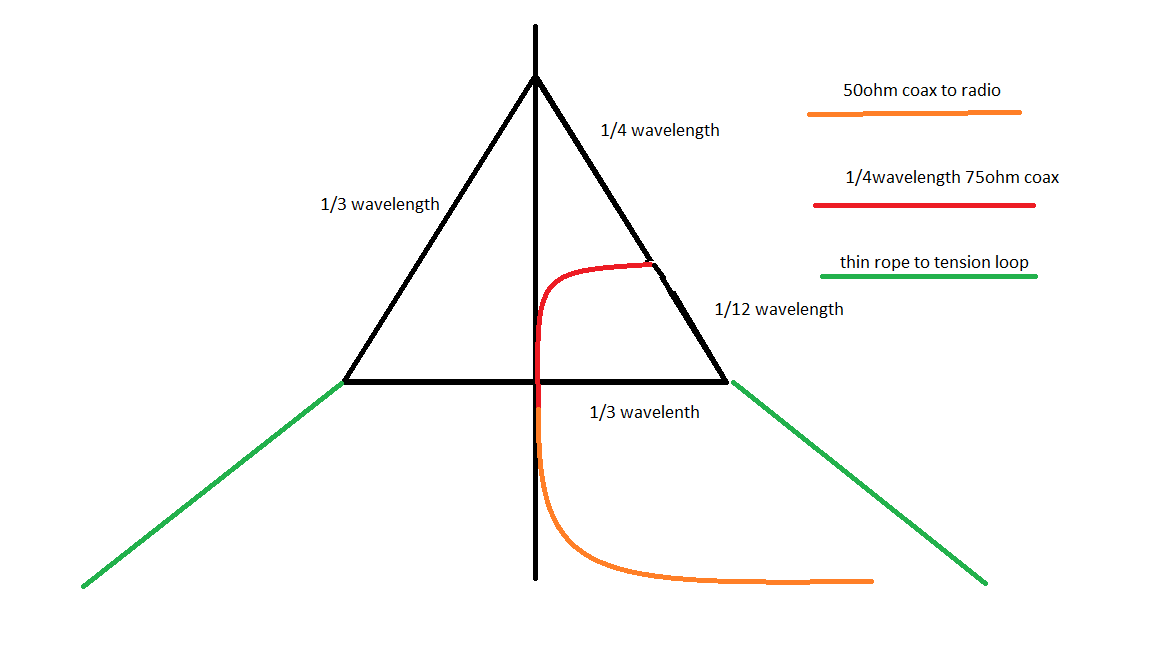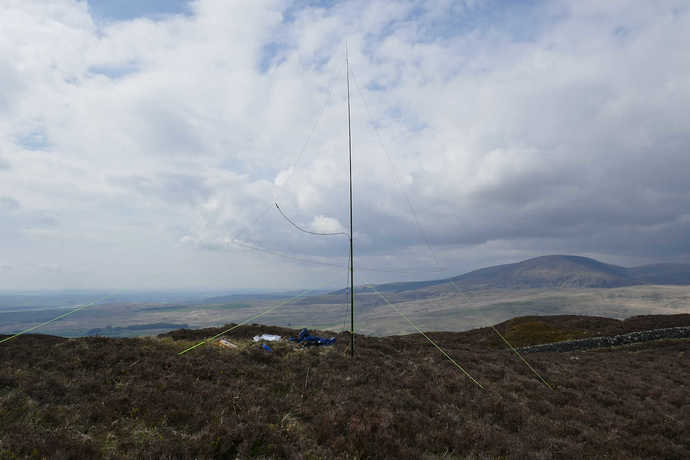Maybe also take a look at rectangular loops if you can handle monoband usage. 2:1 proportioned upright loops have 50 ohm feedpoint, so no need for tuner. Been using ones for 6,10, and 15 meter bands here at home. Needs some support out at the corners to keep them fairly square, but there’s no reason why 6 and 10 couldn’t be portable…and maybe 15m too. Hard to make a complete assessment, but I’d always go for a loop versus a dipole. Hopefully know more about a 10m comparison when the ARRL 10m contest happens in a couple weeks. I’ll have both a vertical and the loop working…and looking forward to it.
As these antennas (loops) have only minor gain unless they have a reflector or director added, a simpler way to get a few db of gain is a DEZ. For 20m the DEZ is about 88 ft long, ie. it is two 5/8 wave elements fed as a doublet. The feed impedance is reactive, with judicious choice of feedline length the reactance can be compensated.
The simplest way of doing all that is the ZS6BKW which is slightly longer than a DEZ but still does have a few db of gain on 20m. Better if it is horizontal and high, like all antennas.
73 Andrew VK1DA/VK2UH
Talking of which, I haven’t done a “test and train” activation ahead of the 12m-10m-6m SOTA Challenge flavour yet - and it starts on Tuesday!
So I’ll take the “somewhere between 10m and 12m” groundplane up Cloud this morning and give it a whirl. CQWW CW on 10m and SOTA chasers on 12m. Probably.
Albeit not exactly a delta loop and neither for HF but for the 6 meter band, following my experiences.
I was missing a 6m antenna and therefore was looking for a simple to build antenna to experiment with during the 6/10/12m challenge. I found a very simple to build delta loop that shows about 50 Ohms at the feed point, by changing the aspect ratios (description in German: Delta-Loop für 6m mit einfachsten Mitteln › HAMSPIRIT.DE).
Then I thought it would be even better (in terms of performance) to build a quad, or for easier construction a diamond shaped quad. DK7ZB has an interesting idea (scroll down to the Rhombic Loop): The DK7ZB Oblong.
Yesterday it looked like I should be able to activate a summit WX-wise in the nearby black forrest, so I hurried in building the loop in the morning. Fortunately, all material was by hand, so I needed less than half an hour to build it.
The first thing after arriving on DM/BW-293 was tuning the loop for resonance and after two cut-offs, my fingers were freezing and it was good enough for a quick try.
Unfortunately, no one was answering my SSB calls on 50.285 MHz, so I have no idea if it really performs. I also gave up after some minutes calling, since no mobile network was available, so I had to use APRS to send a spot that needed further precious time in the cold.
I will definitely try it another time, by tuning the loop more exactly, in warmer weather and easier spotting possibilities.
Even I could only make one local (65km) 10m contact (out of a total of 24) by using my compact EFHW antenna (better on 10m than my standard EFHW and shown at SOTLAS), the activation was great fun with the first snow in this winter season and I definitely have learnt new things!
Update and note to other 6m/50MHz activators in DL:
A kind German ham informed me today that in Germany one can only use the 6 meter band from a fixed station, but not with a portable station, at least until the end of this year.
Official reference: https://www.bundesnetzagentur.de/SharedDocs/Downloads/DE/Sachgebiete/Telekommunikation/Unternehmen_Institutionen/Frequenzen/Amateurfunk/AmtsblattverfuegungenAFu/Mitt1112020.pdf?__blob=publicationFile&v=11
I was aware that only horizontal polarization is allowed in Germany. This was another reason, why I built this diamond quad, fed from below. I informed myself before building the antenna by checking the German band plan from the DARC (German Amateur Radio Club, see https://www.darc.de/fileadmin/filemounts/referate/vus/bandplaene/VHF_Bandplan_6_m_Mai_2020.pdf), but the above mentioned restriction is missing in this leaflet.
I assume in the following days there will be an update in this matter, since the current rules are only valid until 31.12.2020.
73 Stephan
Hi Roman, I would be interested to get the dimensions for other bands. I have used your 20m design on my last 3 activations and been very pleased with it. I sent you an email as well to the address on your QRZ page,
Thanks, Simon
Hi Simon,
thanks for your feedback! The email didn’t arrive, but I can post the dimensions here anyway.
I would be interested in your experience with the delta loop on 20m. Do you have any photos? Did you work DX? I never used the loop for a normal activation because it is more effort to set up than e.g. a random wire. I used it for the VK/ZL S2S events and in HB0, though.
Please find the dimensions for different bands in the following chart:
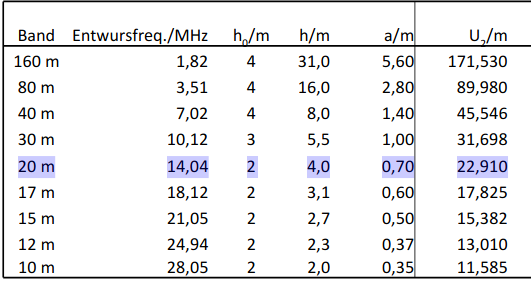
You can find the circumference in the last column (U2/m). It was calculated for a bare wire. When using an insulated wire, the length will be somewhat shorter.
Good luck!
73, Roman
Hi Roman,
Thanks for the quick reply. I tuned my 20m loop centered on 14.2 MHz and used a cheap insulated wire from Sotabeams, but otherwise used the dimensions in your table. Feedpoint measured 50ohm and SWR was excellent over a wide bandwidth. I support it on a shortened DX Commander fibreglass mast and it normally takes me about 20 minutes to set up, depending on the terrain. Best DX so far includes NW7E Oregon, KR7Q Montana, WB6POT Calif. Furthest East is OD5ZZ. Dennis W0JX in Ohio gave me a comparison report with my Hyendfed, the loop being 2-3 S points better - the difference was so marked that he called me again after I had finished our initial QSO using the Hyendfed, after which I had switched to the loop. He wanted to know what I’d done… Comparison reports with EU stations showed little difference between the two. Note that I work QRO with 50w.
Photo from my last activation: In your experience, does it make much difference in performance if the base section is horizontal, drooping or as in the photo, angled downwards?
73 Simon
I can’t make out which wires are which Simon… can you draw over the delta loop wires in that picture to highlight them?
and this was my first activation with the loop, using a Spiderbeam mast. I’ve switched to the DX Commander now as its much lighter. Note the bottom part of the loop is drooping, hence my question to Roman. I think the wires are clear enough in this one.
Thanks for the photos and the report, Simon! I’m glad to hear that it was ‘plug and play’ and you were able to work DX with the delta loop.
Quite impressive that W0JX reported the delta loop being 2…3 S-units above the Hyendfed. The theoretical gain is about 3.5dBi but I believe the low take off angle makes the difference.
It also sounds reasonable that you received similar reports for both antennas across Europe. The low take off angle is of little help here.
We know that variations in the height of the base section will change the resonant frequency and sometimes the impedance. But we never did experiments how the performance will change.
I recommend making the base section as straight and horizontal as possible. Two poles of 2 m length, one for each corner, would be ideal but I think that’s out of scope. In most cases it can be accomplished with a string of about 10 m length in each corner.
73, Roman
So I finally got round to doing the maths and making a loop for 10m. A bit of Pythagoras and a bit of trig and I had some lengths. I used 1005/F(mhz) to get the length of the loop in feet. Then multiply by 12 and 2.54 to get it into sensible units. This version has an apex at the top and is fed part way up one side. Full dimensions to follow.
It needs a 1/4 wave transformer made from 75ohm coax to get the match to 50ohms. I had some 3m lengths of quality satellite coax with N and F connectors so out with the MFJ259b to measure the Vf for the cable, about 0.8. 1/4wave of 75 ohm cut for 28.3MHz and the whole kit and caboodle thrown up in the garden. I connected up a 50ohm feeder to the 1/4transformer and had a tune on the MFJ to see how bad it was.
The design was for 28.3MHz (mid way between CW and SSB sections) and this is what was measured.
Top useable frequency with SWR 1.4
Bottom useable frequency with SWR 1.4
That will do for a first pass. SWR is a bit high for 10FM so I’ll look into that later.
I’ve built loads of antennas but they’ve always needed a bit of fettling, I’ve never hit the design point 1st time before. 
Here are the dimensions
1005/28.3 x 12 x 2.54/100 = 10.82m
1/4 wave = 2.7m
1/3 wave = 3.60m
1/12 wave = 0.9m
I had a 3m piece of 75ohm coax with an N connecttor and F connector. I measured the Vf of the cable as 0.8 using the MFJ259B.
1/4wave coax at 28.3 = 10.82 / 4 * 0.8 = 2.16m
I cut the F end off and bared the wires of the coax That went into a chocolate block and joined to the end of the loop wire. I strung it up on a 5m pole and used some lengths of string to pegs in the ground to hold out the shape. The 75ohm coax is held on the pole with some double sided velcro. There’s a loop mid way along the bottom of the wire to tie that to the pole to stop it waving about in the wind.
Feed is 50ohm coax from the 75 ohm quarter wave transformer to the radio (or MFJ in this case).
Now for a chance to see how well it works.
I was able to actually test this antenna on a summit over the weekend. Main goal of the weekend was for our contest group to get some practice setting up a QRO station and testing new generator and some aerial ideas. Secondary goals were 13cms QSO for me from Pibble Hill GM/SS-232 which is about 20mins drive from the contest site. Tertiary goal was for there to be some 10 SpE and to try this antenna.
Here’s the delta loop deployed on my 5m mast. Cairnsmore of Fleet GM/SS-065 in the background.
Success in all 3 goals  I managed 3x 10m QSOs with chasers F4WBN (SSB) and EA1AER (CW) and another with 9A5O who was working a big pileup of G stations. Nice to receive a 59+ report and on saying I was running about 4.5-5W getting told it was an impressive signal for QRP. Of course SpE is like that. 13cms QSO with Jack GM4COX/P and we operated in the contest. We didn’t blow anything up, drop any masts, break anything. Jury is out as we analyse results and dry out all the gear.
I managed 3x 10m QSOs with chasers F4WBN (SSB) and EA1AER (CW) and another with 9A5O who was working a big pileup of G stations. Nice to receive a 59+ report and on saying I was running about 4.5-5W getting told it was an impressive signal for QRP. Of course SpE is like that. 13cms QSO with Jack GM4COX/P and we operated in the contest. We didn’t blow anything up, drop any masts, break anything. Jury is out as we analyse results and dry out all the gear.
With a WX window and nobody about to get in the way of wires in the garden I have just tweaked the 12m GP. It’s cut for a classic 12m 1/4 λ GP, 3 1/4λ radials at 45degs and a 1/4λ radiator. A quick check showed a quick setup gave a 1.4 : 1 match. This was on a different pole so the height AGL and angles of radials may not be perfect. A bit of fettling got that down to 1.2 : 1.
I cut a new radiator for 10m and swapped out the 12m radiator. After a bit of trimming I got 1.3 : 1 in the CW/SSB section and about 1.9 : 1 up on 29FM part of the band. That will do for me. It’s a 60second job to swap radiators. I could have put a link in but the effort to open/close the link would have been 75% of the effort to change the radiator.
So that’s 2 antennas for 10m, this 1/4λ GP and the delta loop and a 1/4λ GP for 12m. See you on the higher HF bands.
Sorry for being off topic, but I have to correct this misunderstanding.
The legal definition of a fixed station is a station that is not moving while it is operated. Considering this, read §9 (4) AFuV carefully.
Der Inhaber einer Zulassung nach Absatz 1 hat […] die […] dauerhafte Verlegung eines Standortes seiner ortsfesten Amateurfunkstellen vor Inbetriebnahme […] der Regulierungsbehörde anzuzeigen.
The licence holder is obliged to notify BNetzA of a permanent relocation of a fixed amateur radio station.
This means, a temporary fixed operation without further notice is legal. This is exactly what we do when activating a summit, regardless of practical use of an indicator like “stroke-portable”.
BNetzA clarify this under >Weitere Informationen und Links zum Thema Amateurfunk.
Die […] kurzzeitige Errichtung einer ortsfesten Amateurfunkstelle für einen Zeitraum von weniger als drei Monaten, bedarf keiner Meldung gemäß § 9 Abs. 4 AFuV an die Bundesnetzagentur.
The deployment of a temporary fixed amateur radio station for a period of time less than three months does not require a notification according to §9 (4) AFuV.
HB9EAJ linked Mitteilung 111/2020 where BNetzA clarify that the licence holder is not obliged anymore to notify BNetzA beforehand of operating on 6 m. So §9 (4) AFuV fully applies and all DL/DM SOTA activations on 50 MHz are legal, as long as you do not move the station during operation and comply with all the technical terms of use.
Ahoi
Pom
Pom, what is the origin of this definition?
Can we assume a SOTA station on a summit being a temporarily fixed station as you cited here. And does BNetzA have the same understanding?
When looking from a different angle: The army is the primary user on this band. If amateur radio causes interference, they want to know where the interfering station is located (and probably shut it down). This would be rather difficult with temporarily fixed stations.
I would be more than happy to activate on 6 metres but my guts feeling says “No!”
73, Roman
There were lots and lots of stations, think I made 25 (not yet counted) SSB QSOs, some SOTA QSOs (calling CQ SOTA), most 10m QSOs (calling CQ 10m). Some EA1 stations lots of German and Italian stations. No French stations at all. I heard a few from further East calling but they were marginal / weak.
WX was about 6C and many heavy showers, about 8C colder than it should be 
I did work CT and HB9 S2S on 10m which was nice.
Just now MM0ZBH Paul 59 …but working only G and finally give me 58 
